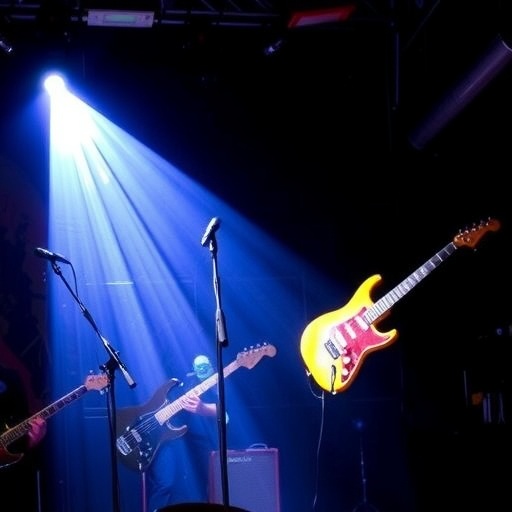At the forefront of melding abstract scientific concepts with sensory experience, researchers at Kobe University have unveiled a groundbreaking web-based application that transforms the elusive mechanics of quantum game theory into an interactive auditory journey. This new platform redefines how we perceive quantum uncertainty and entanglement by translating these principles into a dynamic soundscape, offering users an intuitive means to grasp quantum phenomena through musical interaction.
Quantum mechanics and game theory individually challenge even the most adept minds, each presenting layers of complexity and abstraction that rarely intersect with everyday experience. Nevertheless, Kobe University quantum engineer SOUMA Satofumi has pioneered an inventive fusion of these disciplines, embedding them in a musical context that leverages the spontaneity of jazz and improvisational performance. This convergence is not merely an academic exercise but paves the way for fresh insights into the cognitive and creative dimensions of these fields.
The interactive system developed by Souma and his team invites users to engage in a browser-based ‘quantum jam session’ grounded in the principles of quantum game theory, a sophisticated extension of classical game theory that incorporates quantum mechanical effects. By inputting strategic choices and corresponding musical notes on a digital keyboard, participants witness a real-time synthesis of their interactions, rendered both visually and sonically. This innovative interface effectively simulates the quantum states of superposition and entanglement that define quantum decision-making.
Classical game theory has long served as a robust mathematical framework for modeling strategic interactions where individuals or entities make decisions aimed at optimizing outcomes. It finds applications across disciplines including economics, social sciences, and political analysis. However, quantum game theory transcends traditional bounds by introducing probabilistic superpositions and entanglements between player strategies, where choices are not fixed but exist in intertwined states, influencing each other in profoundly non-classical ways.
Souma emphasizes that while quantum game theory and quantum cognitive science have made significant strides in theoretical and mathematical domains, their intersection with human creativity and expression remains underexplored. His work fills this gap by actualizing these quantum concepts within a musical medium, thus bridging abstract theory with tangible human experience and offering a novel platform for exploring the underpinnings of creativity through quantum principles.
The interactive system leverages the classic prisoner’s dilemma paradigm, where two participants independently choose to cooperate or defect. However, Souma’s quantum interpretation alters the nature of decision-making from discrete choices to probabilistic stances, where users express their inclinations and select musical notes that, once processed via quantum computational rules, generate unexpected auditory outcomes. These outcomes embody quantum uncertainty and interference, resulting in unique harmonies or dissonances emblematic of quantum entanglement.
This auditory manifestation of quantum states marks a pioneering achievement in representational science, transforming intangible quantum interactions into sensory phenomena that users can intuitively understand and explore. The emergent musical dialogues echo the spirit of jazz improvisation, where spontaneous interplay yields complex, evolving patterns that defy predictable outcomes, mirroring the probabilistic and interdependent characteristics inherent in quantum systems.
Looking ahead, Souma and his collaborators aim to expand this proof-of-concept into more sophisticated models involving multiple participants and higher-dimensional quantum states. By incorporating multiparty decision-making frameworks and complex qubit manipulations, the system will explore richer, multidimensional creative interactions. This trajectory holds promise for advancing not only our comprehension of quantum cognition but also for informing the development of AI algorithms and quantum computing architectures inspired by human creativity.
This interdisciplinary initiative epitomizes Kobe University’s dedication to pioneering research that transcends conventional boundaries. By harnessing the principles of both the natural and social sciences, the university fosters innovative approaches to address multifaceted challenges, exemplifying how fusion between fields—like quantum physics, game theory, and music—can yield unprecedented avenues for learning and discovery.
Souma’s work also invites broader reflections on the nature of creativity itself. By demonstrating how emergent patterns in music can serve as analogs to quantum processes, this research stimulates inquiry into how human decision-making and artistic expression might be modeled through the lens of quantum mechanics. The intersection thus offers fertile ground for reimagining cognitive science, enhancing AI creativity, and informing quantum technological design.
The system’s accessibility via a web browser democratizes engagement with quantum concepts, allowing users with diverse backgrounds to interactively explore the intricate dance of cooperation, competition, and uncertainty that defines quantum games. This hands-on experience moves beyond abstract formulas, providing a multi-sensory gateway to deep scientific ideas and nurturing fresh perspectives on the entanglement of logic, strategy, and art.
By synthesizing sound generation with quantum game theoretical frameworks, this interactive platform exemplifies a novel educational approach wherein complex scientific theories are not merely explained but experienced. It challenges traditional didactic methods, suggesting that immersive, creative interactions can significantly enhance comprehension and inspire curiosity about the quantum world.
Ultimately, this fusion of quantum science and musical creativity underscores an exciting frontier in research where technology, art, and physics converge. Souma’s initiative lays the groundwork for future explorations into quantum-enabled artistic platforms, potentially catalyzing breakthroughs in how we understand and harness creativity within both human and artificial agents.
As this project evolves, it invites multidisciplinary collaboration among physicists, cognitive scientists, musicians, and computer scientists, signaling a vibrant future for research at the nexus of science and the arts. The implications extend beyond academia, hinting at revolutionary paradigms for education, entertainment, and quantum technology development.
Subject of Research:
Development of an interactive sound generation system based on quantum game theory.
Article Title:
Development of an Interactive Sound Generation System Based on Quantum Game Theory.
News Publication Date:
29-Oct-2025.
Image Credits:
Kobe University, created with material from Akshar Dave and Puk Khantho via Unsplash and Nilhope via Wikimedia Commons.
Keywords:
Quantum game theory, quantum mechanics, auditory interaction, quantum entanglement, quantum uncertainty, prisoner’s dilemma, interactive music system, computational modeling, creativity, quantum cognition, artificial intelligence, quantum computing.




